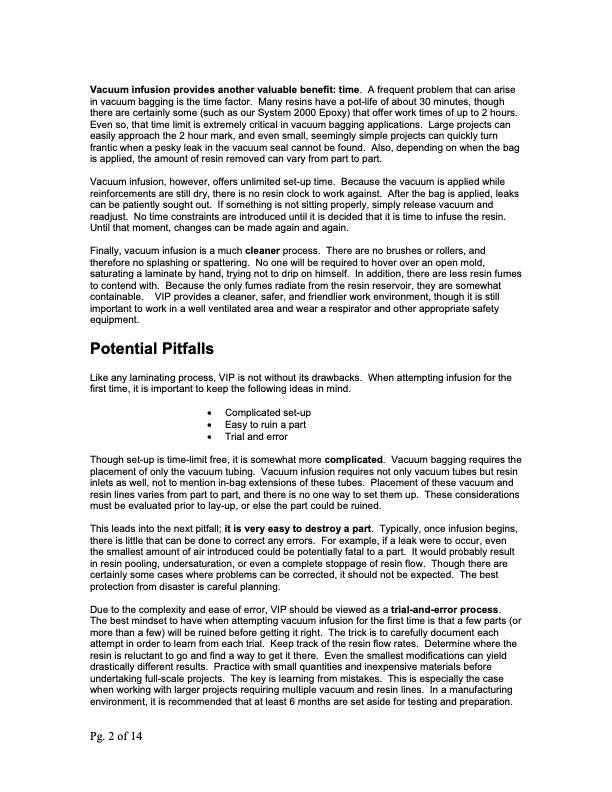
PDF Publication Title:
Text from PDF Page: 002
Vacuum infusion provides another valuable benefit: time. A frequent problem that can arise in vacuum bagging is the time factor. Many resins have a pot-life of about 30 minutes, though there are certainly some (such as our System 2000 Epoxy) that offer work times of up to 2 hours. Even so, that time limit is extremely critical in vacuum bagging applications. Large projects can easily approach the 2 hour mark, and even small, seemingly simple projects can quickly turn frantic when a pesky leak in the vacuum seal cannot be found. Also, depending on when the bag is applied, the amount of resin removed can vary from part to part. Vacuum infusion, however, offers unlimited set-up time. Because the vacuum is applied while reinforcements are still dry, there is no resin clock to work against. After the bag is applied, leaks can be patiently sought out. If something is not sitting properly, simply release vacuum and readjust. No time constraints are introduced until it is decided that it is time to infuse the resin. Until that moment, changes can be made again and again. Finally, vacuum infusion is a much cleaner process. There are no brushes or rollers, and therefore no splashing or spattering. No one will be required to hover over an open mold, saturating a laminate by hand, trying not to drip on himself. In addition, there are less resin fumes to contend with. Because the only fumes radiate from the resin reservoir, they are somewhat containable. VIP provides a cleaner, safer, and friendlier work environment, though it is still important to work in a well ventilated area and wear a respirator and other appropriate safety equipment. Potential Pitfalls Like any laminating process, VIP is not without its drawbacks. When attempting infusion for the first time, it is important to keep the following ideas in mind. • Complicated set-up • Easy to ruin a part • Trial and error Though set-up is time-limit free, it is somewhat more complicated. Vacuum bagging requires the placement of only the vacuum tubing. Vacuum infusion requires not only vacuum tubes but resin inlets as well, not to mention in-bag extensions of these tubes. Placement of these vacuum and resin lines varies from part to part, and there is no one way to set them up. These considerations must be evaluated prior to lay-up, or else the part could be ruined. This leads into the next pitfall; it is very easy to destroy a part. Typically, once infusion begins, there is little that can be done to correct any errors. For example, if a leak were to occur, even the smallest amount of air introduced could be potentially fatal to a part. It would probably result in resin pooling, undersaturation, or even a complete stoppage of resin flow. Though there are certainly some cases where problems can be corrected, it should not be expected. The best protection from disaster is careful planning. Due to the complexity and ease of error, VIP should be viewed as a trial-and-error process. The best mindset to have when attempting vacuum infusion for the first time is that a few parts (or more than a few) will be ruined before getting it right. The trick is to carefully document each attempt in order to learn from each trial. Keep track of the resin flow rates. Determine where the resin is reluctant to go and find a way to get it there. Even the smallest modifications can yield drastically different results. Practice with small quantities and inexpensive materials before undertaking full-scale projects. The key is learning from mistakes. This is especially the case when working with larger projects requiring multiple vacuum and resin lines. In a manufacturing environment, it is recommended that at least 6 months are set aside for testing and preparation. Pg. 2 of 14PDF Image | Vacuum Infusion

PDF Search Title:
Vacuum InfusionOriginal File Name Searched:
FibreGlast_Vacuum_infusion_process.pdfDIY PDF Search: Google It | Yahoo | Bing
5,000 BF Shipping Container Lumber Dry Kiln For Quality Lumber The 5,000 BF container kiln consists of one 40 foot high-cube aluminum shipping container... More Info
Shipping Container Lumber Dry Kilns by Global Energy Global Energy designed and developed the container kiln back in 1991. The purpose is to give access to portable sawmill owners, furniture makers, and small business the value added profit of dry kiln lumber and quality hardwoods... More Info
Vacuum Kiln Conversion Kit for Lumber and Wood Dry Kilns Convert your existing conventional dry kiln into a fast drying vacuum kiln. Similar to vacuum bagging in the boat building and aircraft industry, we have come up with a proprietary process which allows you to build a very simple vacuum kiln at a fraction of the price, and without the intensive conventional metal chamber structure... More Info
Vacuum Pump Cart System for Bagging Clamping Wood Drying and more Vacuum Cart with 2HP Pump and Dual Pistons with multiple multiplex vacuum ports and liquid reservoir... More Info
Vacuum Bagging Basics Vacuum bagging is a method of clamping, which has traditionally been used in the composites industry, but can also be used for vacuum drying materials, including wood products... More Info
| CONTACT TEL: 608-238-6001 Email: greg@globalmicroturbine.com | RSS | AMP |